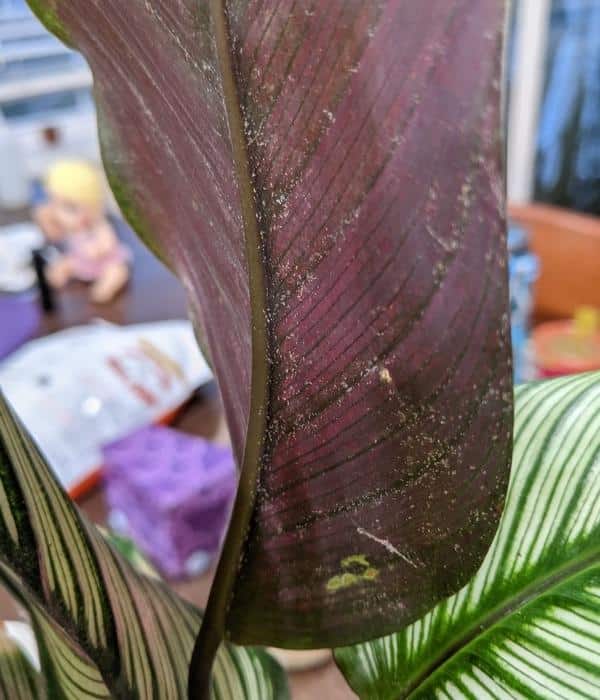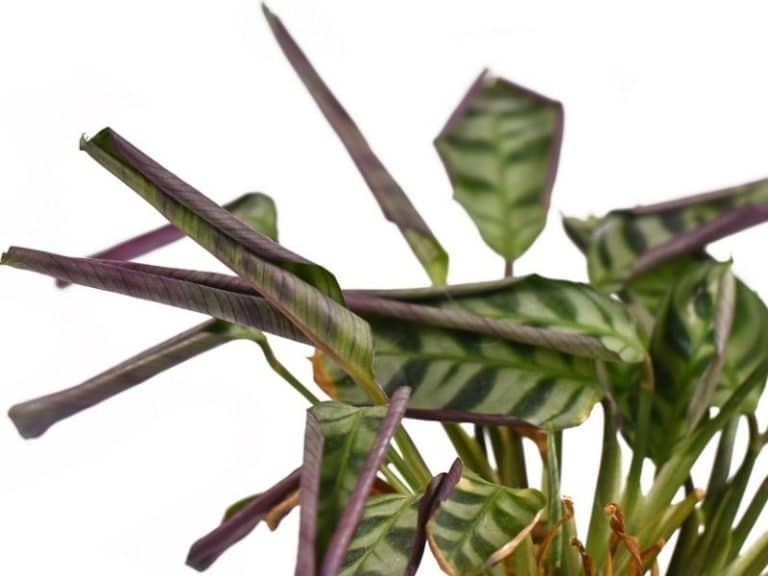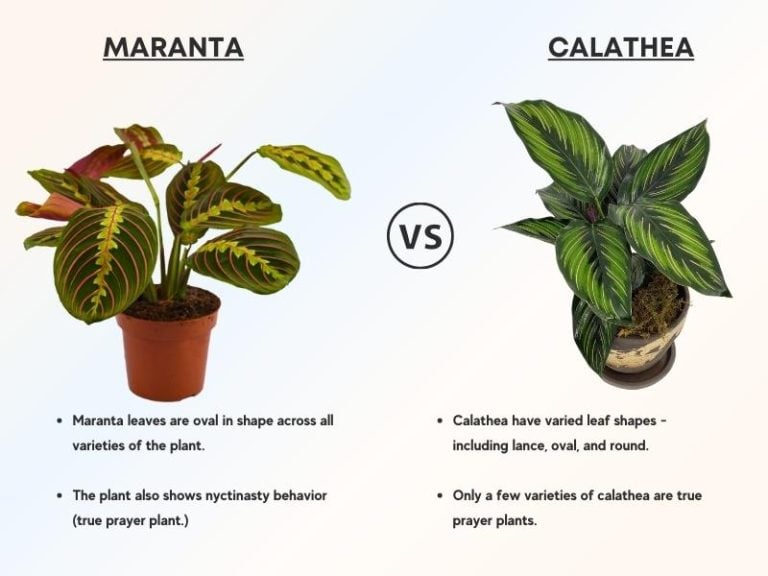13 Beautiful Types of Calathea (Pictures + Rare Varieties)
Calatheas occur in several variations. They are native to the tropical climates of Latin America and belong to the Marantaceae family. Therefore, their growth requires significant moisture.
There are 60 species of calathea plants, including the C. Freddie, C. pinstripe, C. Orbifolia, C. Rufibarba, and Calathea Crocata. Other common varieties include C. Zebrina, C. Rufibarba, C. Warscewiczii, and C. Musaica. They derive their names from the various leaf patterns, variegation, and height.
Calatheas make beautiful indoor and outdoor plants, especially where there’s indirect sunlight and 60% humidity. I will discuss thirteen beautiful varieties of calathea, including the rarest and the easiest calathea to care for.
How do you identify calathea?
Identifying calathea from hundreds of species can be challenging. Calatheas are named based on their height, foliage spread, and leaf patterns to make the identification easier. The plants rarely produce flowers, but their leaf variegations make them stunning.
Here are the main identifying features for calathea:
- 2 feet to 1 meter maximum height: Calathea’s growth is pretty slow and most varieties will stop growing taller when they reach about two feet to 1 meter high.
- Broad foliage: Calathea are known for their broad, dark green, colorful foliage. Leaves have colorful patterns ranging from white, rose, yellow, or even olive. Bright colors such as red, orange, and pink also appear in some varieties of calathea. That is why they are commonly referred to as zebra or peacock plants.
- Changing leaf orientation: Since they belong to the Marantaceae family, they display significant sensitivity to changing lights. Calathea leaves move during the day relative to the sun’s position in the sky and stand up at night. That “praying” behavior is more noticeable in some types of calathea than in others.
- They fade in excess sunlight: alathea can not survive excess sunlight exposure. You can use a lux meter (the light meter) to determine the light quality of the place you intend to position the calathea. Growing calathea in bright but indirect light exposure of 10,000 lux is recommended. Excess light initiates fading of calathea’s beautiful colors and patterns.
- They have rhizomes: You can identify calathea by their specialized rhizomatous stems. However, these can only be seen when you uproot the plant.. Healthy and vigorous calathea rhizomes play an essential role in propagation. The best time to propagate and repot calathea is in spring, and the best way to do it is by division at its root system.
While these are the basic characteristics you can use to identify the plant, different varieties of calathea have their own unique features as well. I’ve listed and described 13 of the most common calathea varieties below.
13 Beautiful Varieties of Calathea
Since the genus Calathea has numerous varieties of plants with attractive foliage, you’ll have a wide range of options to choose from for your indoor or outdoor gardens. For the most part, the growth pattern and color of the foliage are the most distinguishing features of calathea that you can use to select the perfect plant for your indoors.
Here are the 13 different types of calathea:
1. Calathea Freddie
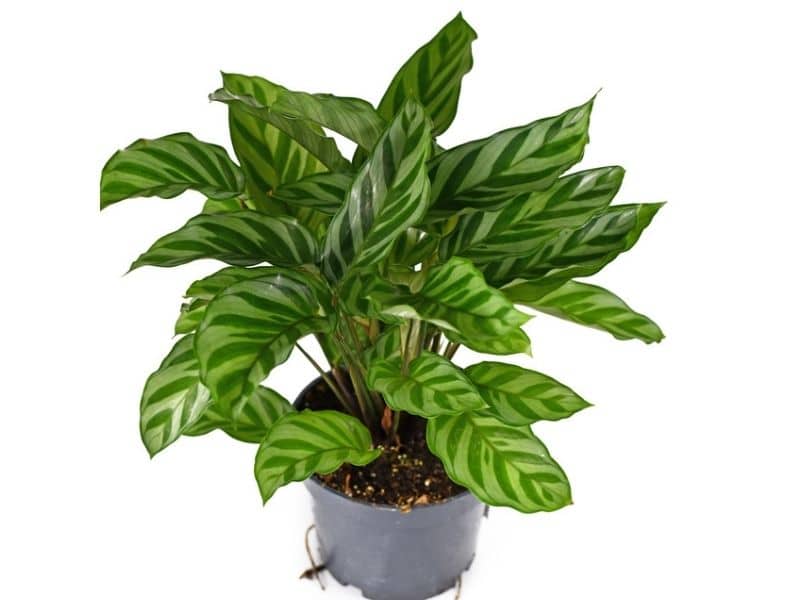
“Freddie” is a variety of calathea native to the Brazilian tropics. It spreads its leaves with the rising sun. Calathea Freddie’s leaves are light-green and zebra-striped in darker shades. The leaves are also shiny, elongated, pointed at the tip, and grow around the stem in alternate patterns.
“Freddie” produces a long stalk-like inflorescence upon which it blooms white flowers. If planted indoors, it will reach about 3 feet tall. Like most calathea varieties, Freddie shows optimal growth in bright indirect light conditions. I advise watering calathea Freddie once a week or bi-weekly, mainly when the top one inch of the potting soil is dry.
Excess watering can result in root rot. So, check the soil frequently and create drainage holes for your plant.
2. Calathea Orbifolia
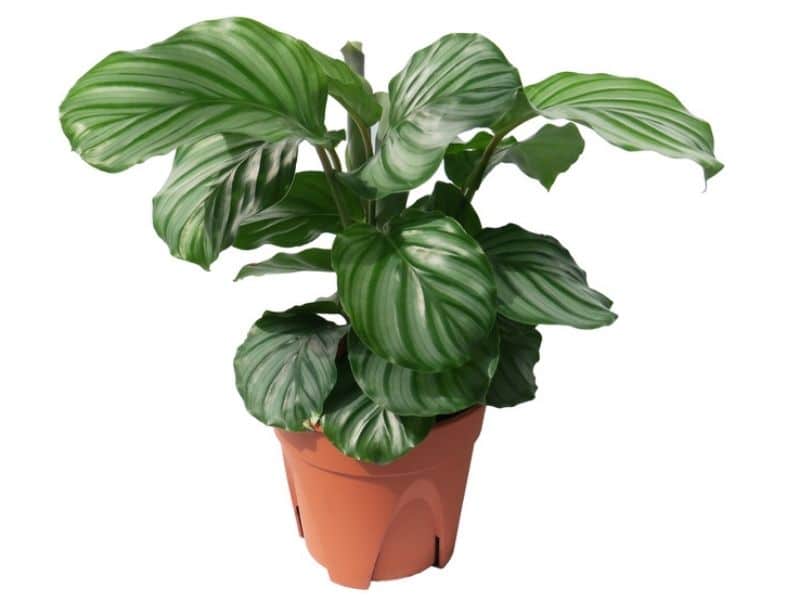
Orbifolia is native to Bolivia and varies significantly from “Freddie.” It is one of the largest calathea varieties. Unlike the elongated and pointed leaves of calathea Freddie, calathea Orbifolia produces large oval silvery-green leaves. It produces designer-quality foliage with dark veins and silvery bands, making it radiant and tastefully beautiful.
C. Orbifolia loves high humidity, medium light, and well-drained and constantly moist soil. Growing it at temperatures between 65°F and 75°F will give you a healthy plant for several years. Indoors, it grows moderately fast to a maximum height of three feet and up to one foot wide.
Grow calathea Orbifolia near windows or on tabletops receiving filtered light for stunning outcomes.
3. Calathea Burle-Marxii
Calathea Burle-Marxii is also called the Fishbone Prayer Plant. It has long, dark green leaves and V-shaped stripes that instantly attract attention. It is a low-growing plant that stops growing upon reaching 20 inches tall and about 16 inches wide. Therefore, it is well-suited for indoor care.
A moderate to high humidity of about 40% is recommended to keep the leaves of Calathea Burle-Marxii vibrant healthy. You can also care for this type of calathea by fertilizing once a month with an all-purpose houseplant fertilizer like the Dyna-Gro 719000 Grow Plant Food. To increase its indoor lifespan, re-pot Burle Marxii once every two years.
4. Calathea Crocata
Also known as the Eternal Flame plant, Calathea Crocata is one of the most beautiful calathea varieties you can buy. Their brightly colored green leaves are puckered and ribbed, with a blend of other colors like purple on their underside.
The Eternal Flame plant blooms orange flowers that emerge like flames, hence its name. The flowers rise above the foliage for about ten centimeters and stay dark and shiny for two to three months before dying. Unlike most calatheas, Crocata blooms on and off throughout the year but more heavily during summer.
To grow it indoors, mix regular potting soil with peat and compost to improve drainage, and place Crocata in bright indirect light.
5. Calathea Lancifolia
Like calathea Freddie, calathea Lancifolia also moves its leaves up and down relative to the sun’s position in the sky. A healthy Lancifolia moves its leaves upward at night and lowers them in the daytime. However, you should not confuse the movement with wilting or drooping in calathea, which are signs of an underwatered plant..
Generally, its leaves are upright and lance-shaped with burgundy-red undersides that feel velvety to touch. They grow to 1.5 feet indoors and about twice as much outdoors. The leaf patterns and attractive foliage give calathea Lancifolia a rattlesnake look, hence its common name – the rattlesnake plant.
Most importantly, calathea Lancifolia requires moist, warm, and partially shaded areas to thrive.
6. Calathea Makoyana
Calathea Makoyana resembles the elegance of a peacock’s tail. It is a tall, slender and excellent houseplant that grows up to two feet tall. Makoyana leaves feature large dark green ovals and thin darker lines with purple undersides.
It is native to South America and thus requires 60% humidity, 65°F-85°F temperature, and rain or distilled water to thrive. Very low humidity and too much direct light can result in browning and fading of Makoyana’s leaves.
You can propagate calathea Makoyana by division when it has grown large enough. Propagation is not only essential for getting more plants but also to keep the calathea healthy.
A fertilizer with an NPK ratio of 3-1-2 is ideal for strength and disease resistance in Makoyana.
7. Calathea Musaica
Calathea Musaica’s leaves are medium-green and feature an intricate network of yellow-green lines across the entire leaf surface. A mature calathea Musaica is two feet tall and about three feet wide. Calathea Musaica is one of the most difficult calatheas to care for as they require up to 80% humidity.
Attaining that humidity level may require humidifiers or ingenious ways of keeping the plant moist. For example, you can place potted calathea Musaica on a pebble tray filled with water. Evaporation from the pebble tray will keep the plant moist. Like most types of calathea, Musaica thrives in bright, indirect light.
Water your plant when the top two inches of the soil dry out.
8. Calathea Ornata
Calathea Ornata species are popular indoor plants for two reasons. Unlike calathea Musaica, caring for calathea Ornata is relatively easy. Secondly, they produce violet bottoms and beautiful pink stripes on their large green leaves, making them very attractive. Calathea Ornata are commonly called pinstripe plants for their gorgeous veined leaves.
They grow two feet tall and spread their foliage two feet wide. You can pot calathea Ornata outdoors to add beauty to your deck, porch, or patio. However, this variety of calatheaa cannot grow in a puddle. If the pot does not have drainage holes, you should create them or re-pot the plant.
Calathea Ornata thrives in bright indirect sunlight. Otherwise, prolonged exposure to direct sunlight will fade the beautiful details in its leaves.
9. Calathea Roseopicta
Calathea Roseopicta is also called Rose painted calathea. It reaches around 40 to 60 centimeters tall. Rose painted calathea grows moderately fast and blooms small white and purple flowers during the summer. The leaves of calathea Roseopicta are elliptical, with pink stripes emanating from the midrib.
Its leaves are visually striking and ideal for balconies, patios, lightly curtained windows, and tabletops. Avoid seating your calathea Roseopicta in direct sunlight or near cold drafts. A healthy and lively calathea Roseopicta folds the leaves slightly at nighttime and opens during the day.
10. Calathea Rufibarba
Calathea Rufibarba is among the most beautiful calathea we have on this list. Its leaves are long, slender, and wavy. The upper side of mature leaves is dark green, while young leaves are light green. In contrast, the lower side of Rufibarba leaves displays various colors, including burgundy and maroon.
Calathea Rufibarba also has bright red stems and tiny hairs on the leaves, giving it a velvety feel. It can grow to about three and a half feet tall. Caring for Rufibarba involves mimicking the tropical climates at your home, particularly the humidity levels.
Keep the soil moist at all times and water with soft water like rainwater, distilled water, or purified water.
11. Calathea Warscewiczii
Calathea Warscewiczii has two tones of green color on the upper side of the leaf – dark green and light green patterns. The stems and bottom of the leaves are burgundy-colored. It rarely blooms indoors. Therefore, it is kept for its beautiful foliage.
This variety can be very difficult to care for. To keep it happy, I advise that you maintain a humidity above 50% and temperatures between 65 and 85ºF. Calathea Warscewiczii is ideal for indoors as it grows only three to four feet tall and wide.
12. Calathea Zebrina
Calathea zebrina‘s lime green zebra-like stripes will compliment bright-colored indoor spaces. The leaves are velvety and purple on the underside. It grows moderately fast and can reach up to one meter tall in a good soil mix. More specifically, mix potting soil, peat, and perlite in the ratio of 1:2:2 for calathea zebrina.
Like most calathea varieties, exposing the vibrant leaves of “zebrina” to excess sunlight can diffuse their markings. The more indirect and partial the light is, the more conspicuous calathea zebrina becomes. You should fertilize the plant during spring and summer. Do not over-fertilize or fertilize calathea zebrina in winter.
13. Calathea Beauty Star
Calathea beauty star is a hybrid characterized by deep green and relatively narrow leaves with pink stripes. The strips can also be pale green, white, or silver. These vivid leaf patterns make the calathea beauty star a popular houseplant. The mature height and width of the plant are three feet and 16 inches, respectively.
Caring for it involves positioning the pot in a warm place with high humidity. “Beauty stars” are susceptible to overwatering and may die very quickly, which is whyI do not recommend it for beginners. However, it will thrive in bright, indirect light like the other types of calathea.
What is the rarest calathea?
Calathea “White Fusion” is one of the rarest varieties of calathea. It has large glossy leaves dominated by white stripes and edges. As with most of the varieties, its underside is purple. Being a variegated type, white fusion makes for a magnificent cultivar of calathea despite being rare due to its slow growth rate.
Unlike calathea Rufibarba or calathea Roseopicta, calathea “White Fusion” is quite difficult to find. It will usually be much more expensive if you find it in a plant shop or a garden center.
What is the easiest calathea to care for?
The easiest calathea to care for is calathea lancifolia. It grows well in most indoor settings without the need for much adjustment. For example, 50% indoor humidity and 70-85°F temperature are ideal for it to thrive unlike calathea Musaica, which requires up to 80% humidity to survive.
Constantly check the potting mix, never allowing the soil to dry out. Ensure that the container holding calathea Lancifolia has drainage holes.
References
- Bruce K. Kirchoff, American Journal of Botany: Floral Organogenesis in Five Genera of the Marantaceae and in Canna
- Wikipedia: Calathea Overview
- R.T. Poole, A.R. Chase, and L.S. Osborne, University of Florida IFAS Extension: Calathea Production Guide


